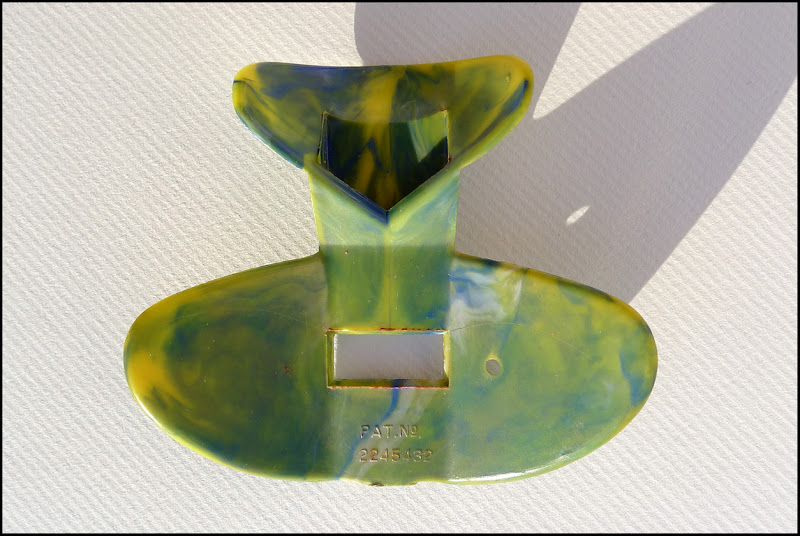Followed by : Humanatone - part III : the Gretsch metal era
En 1903, James J. Stivers launched the original Humanatone nose flute, made of tin plate, and refering to Carter's and Couchois' patents (adding later Leech-Couchois). On that purpose, he filed the trade-mark Humanatone in july 1904 (N°43264), then in August 1905 (with a new typo, N°45056).
The metallic Humanatone was a best and long seller, and Stivers renewed the trademark on Feb. 9th, 1926 (N°208915), and then twenty years later, on Feb. 9th, 1946 (same reg. number). I assume that in 1946, the metal Humanatone was not available anymore, replaced in the catalogs by its competitor the Magic Nose Flute, but it still features in the 1941 Favorite Mfg. Co. catalog.
(It would be rather logical that the metal Humanatone production stopped with the WWII, when iron became dedicated in order of priority to weapons rather than nose flutes, despite that bad playing could have been disastrous for the enemy...)
Anyway, the brand survived. On Jul. 19, 1947, the trade-mark was bought and renewed by the Fred Gretsch Mfg Co. (same number 208915), which renewed it again on Feb. 9th, 1966). However, before Gretsch bought the brand, a Gretsch plastic nose flute was already available, following the design of Ernest Davis' patent, as it can be seen in the 1944 F.A.O. Schwarz catalog...
(Had Gretsch bought the whole Humanatone Co. to Stivers, then took some time to register the trade-mark under its own brand ?).
So, it is possible to date the first plastic Humanatone between Jan. 22th, 1940 (when Ernest W. Davis filed his patent), or more probably 1942 (after Pearl Harbor attack and the beginning of war) and autumn 1943, when the Christmas toys catalogs were issued.
The very day the brand was bought, the Billboard published an advertising promoting the Gretsch Humanatone.
The packaging evolved. The first boxes were blue, and it exists a box version ready to be send to the boys in the service! It just needed to be stamped and address filled.
Then the boxes flattened, and received a two colored design (this graphic design was also applied to the metal japanese Humanatone). I know 2 versions of this box, one is beige and orange, and the other, less scarce, beige and bordeaux.
 |  |
 |  |
The other differences can be seen in the stampings and on the « true tremolo » hole, which got enlarged a bit in diameter (and lost its conical shape). More, the mould injection entrance has been modified : on the early flutes, the plastic was injected by the very base of the mouth cap, leading to a unattractive edge. Next, the polystyrene was cast from the rear side of the mouth cap, as it can be seen with the circular "scar" apparent at this place.
Apart of the stampings and the quality of plastics (which was polystyrene at the beginning, before to become PVC nowadays), the main difference between the Fred Gretsch Mfg. Co. Humanatones and the contemporary ones by Grover-Trophy Music Co., was the injection of several colors plastic pellets in the moulds, leading to beautiful swirled colors, sometimes quite psychedelic!
Now, for the pleasure of the eyes...
 |  |
 |  |
 |  |
 |  |
Thanks a lot to him for having indulged my collector's greed !
---
About metal Humanatones, check :
Humanatone - part I : the metallic era
New Humanatone ads
The Two metal Humanatones
Another metal Humanatone
Humanatone boxes
Another Humanatone box
Humanatone: A very early user manual
A Humanatone and clones chronology
A Humanatone in 1892 ?
Rectification: Humanatone appearance date
And on later Humanatones :
Humanatone - Part II : the Gretsch plastic era
Humanatone - Part III : the Gretsch metal era
---


















